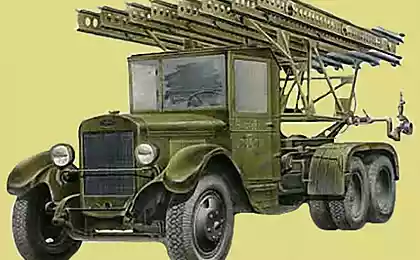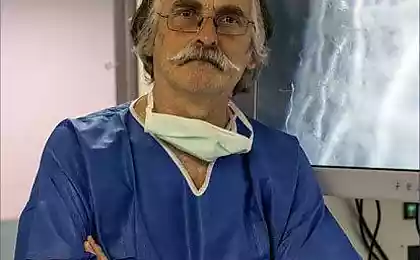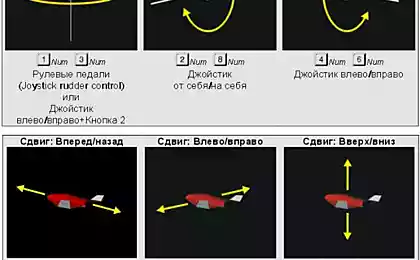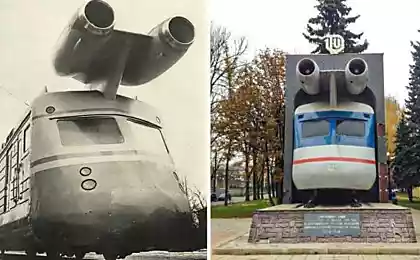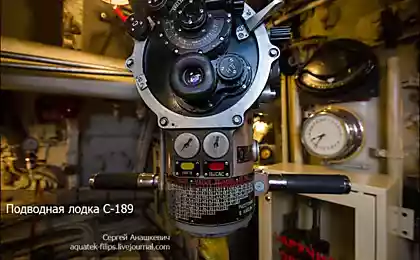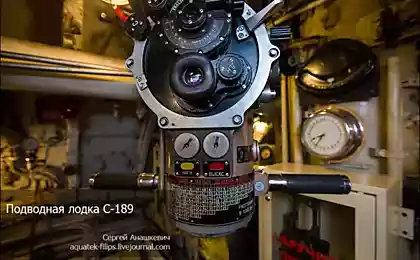1225
"Investigation of outer space rocket appliances."
Rocket
Countdown History of Cosmonautics decided to conduct in May 1903 - that is when an article was published in Kaluga-taught scientist Konstantin Tsiolkovsky "Investigation of outer space rocket appliances." It scientist has shown that flight into space may be implemented using only missiles with engines with liquid fuels. There he led a formula that now bears his name and which linked the speed of the rocket with its mass and with a flow rate of combustion products. Using this formula, you can easily determine which fuel suitable for space rocket, and what - no.
The article went unnoticed, but because later theorists Space - Frenchman Robert Esnault-Pelterie, American Robert Goddard and the German Hermann Oberth - made its own calculations, independently came to the same conclusions.
The first liquid fuel rocket created and launched by Robert Goddard. It happened March 16, 1926 in Obёrne (Massachusetts). A miniature missile «Nell», is used as a combustible fuel, and an oxidizer - liquid oxygen, climbed to an altitude of 12, 5 m. The result is modest, but by that time the name of Goddard was already widely known - about it wrote as a man who almost tomorrow is going to fly to the moon.
Sensational plans for the publication of the American engineer led to increased interest in the missile and space topics in the German republic and Soviet Russia. At the end of 1923 Hermann Oberth published his fundamental work "The rocket into interplanetary space." In addition to her calculations were given sketches of missiles of two types: sub-orbital (for the study of the higher layers of the atmosphere) and space (to fly into orbit and to the Moon). Affected Technical conceived project - nothing like this in Europe are still not there. In Germany, there was a rocket boom, which eventually contributed to the advancement of Wernher von Braun - a talented designer, under whose leadership in the early 1940s were built heavy ballistic missiles A-4, infamous as the V-2.
After the publication of Oberth Konstantin Tsiolkovsky still managed to defend his priority in theoretical astronautics, and in Soviet Russia he found followers.
Konstantin Tsiolkovsky
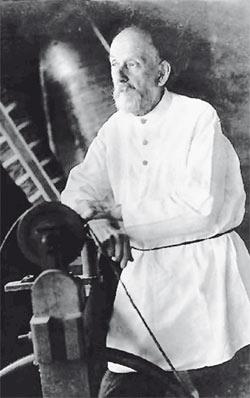
Engineer Friedrich Zander and aircraft designer Sergei Korolev in Moscow created a study group's Jet Propulsion (GIRD), which developed ballistic missiles and gliders with rocket engines - rocket planes. In Leningrad Gas Dynamics Laboratory (GDL) missile issues involved "dvigatelisty" Valentin Petrovich Glushko. August 17, 1933 GIRD employees launched the first Soviet liquid rocket - GIRD-09.
In October 1933, based on the GIRD and GDL set Jet Research Institute (RNII). It was a purely military organization, and themes fly into space there is not openly discussed. Nevertheless, among the projects and the rocket it was RNII "service engaged not only fighting, but also a live load."
The designs of the Soviet missile before the Second World War could not be realized. Guide RNII came under repression. They were arrested and have been "prison universities" Korolev and Glushko. Of all the many developments in the war RNII only used rocket mortars Truck mounted BM-13 - the famous "Katyusha».
However, experience with ballistic missiles V-2, which the Nazis fired on London forced the Soviet leadership to think, and when the war ended, in defeated Germany military experts went to examine the missiles, to reproduce them in our environment and create a more perfect.
On the basis of the artillery factory № 8, located in Podlipki near Moscow, was organized by the NII-88, and in August 1946, the chief designer of the R-1, exactly reproduces the German V-2, was appointed Sergei Pavlovich Korolev.
To test missiles in the vicinity of the village of Kapustin Yar in the Astrakhan region constructed landfill. The first series of launches carried out in the autumn of 1947. V-2 rocket, assembled by the Soviet and German specialists from captured nodes, showed good results: the maximum flight range was 274 km.
A year later they were replaced at the start of the domestic P-1, but the test turned a succession of disasters - said the backlog of domestic technology. He managed to overcome the year, and the fall of 1949 a new cycle starts has passed without an accident.
P-1 inherited all the flaws of V-2. This single-stage rocket fuel mixture alcohol-oxygen had a relatively small range of flight (300 km) and low load capacity (one ton). Sergei Korolev hatched plans to create a truly cosmic rocket and knew that with the P-1 to implement them is impossible. Therefore, in parallel with its increasing its Bureau undertake the development of the extended R-2 missile with a flight range of 600 km. While working on the latter was feared that the return to the peak of a ballistic trajectory, which was already out of the atmosphere, long missile faults and overload warhead is delivered to the target. Then, the idea to make a detachable head part. The idea tested in the R-1, effectively creating a new modification of the missile - P-1A. The "Annushka" (as it was called missile troops) was the fortune: it became the first national geophysical rockets with lifting height of more than 100 km. The detachable warhead scientists placed the recording equipment, and July 22, 1951 at the height of the space went two living beings - mutts dezik and Gypsies.
Preparing the rocket GIRD-09 to run.
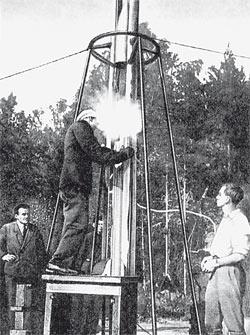
However, neither the P-1 or P-2 was not satisfied with the military and political leadership of the USSR - from the Bureau of Korolev waiting intercontinental missile with a range of 8,000 kilometers, capable of delivering a thermonuclear charge weight of 5, 5 tons to the United States. Calculations show that a single-stage rocket can not provide intercontinental range with such a payload. But the two-stage rocket is technologically complicated. How to ensure its stability in flight? How to start the engine of the second stage after the separation of the first? In the early 1950s, no one could give a confident answer to these questions.
And then matured original idea of a "package". She suggested Mikhail Tikhonravov - Korolev associate of GIRD and designer of the first Soviet rocket GIRD-09. Based on the works of Tsiolkovsky, Tikhonravov showed that the stage can not be connected in series and in parallel - so you can start to provide all levels at the start and achieve the required load capacity.
As a result of further research design was born two-stage rocket R-7 ("Seven") with engines running on kerosene and oxygen. It consisted of a central unit A (second stage), similar to a giant spindle is surrounded by four tapered "marginalia" (the first stage) - blocks B, C, D. July 24, 1954 the preliminary design of the R-7 was completed, and that summer issued technical specifications in related organizations.
Preparation of R-1 at Kapustin Yar.
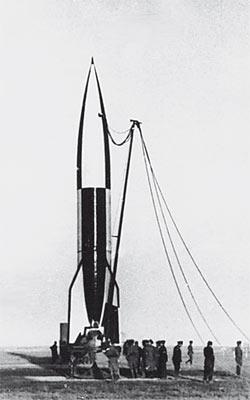
Spaceport
More before it was completed sketch project, started by the Commission on the choice of locations for the new landfill: Kapustin Yar could no longer provide a test of a new missile. In the end the choice was stopped on Kazakhstan, close to the railway station Tura-Tam.
January 12, 1955 in Tyr-Tame first landed landing military builders. They immediately set to work preparing the way for the arrival of the special train from Kapustin Yar. The construction of the landfill was carried out accelerated pace. Already in June 1955 began to build "object 135" - the first launch complex, later known worldwide as "Gagarin's Start".
In the design of the R-7 considered various options complexes. A key question remained build a rocket on the launch pad. Sergei Korolev, and the chief designer of the ground complex Vladimir Pavlovich Barmin settled on the simplest version: transported and placed on the launch pad all the blocks one by one, and then connect them to the second stage. But such an arrangement, a rocket gets very wide at the base. The chief designer of the control system Z Pilyugin gave a negative opinion - his calculations showed that an increase in the lateral thrust blocks there significant tipping point; when combined with such a moment a gust of wind control system can not ensure the stability of the rocket during launch. Alternatively Pilyugin required to protect P-7 by wind action by a high wall. Barmin bluntly refused to discuss the decision: starting position P-7 and without walls looked bulky. Then there was found an unconventional way - to collect the rocket in assembly and testing facility (MIK), then horizontally to transport it by rail to the launch pad, and there are not placed directly on the support, and hang in the power zone in reclining at her rise farms. Immediately simplify and launch pad and the missile itself has become sleeker and lighter.
During the construction of the complex was not without problems. Just a few days before the start of the space on demand "camoufleur" of the General Staff, was transferred from the platform to the lowland. But after construction began it became clear that the existing data exploration can not be applied to the new position start: instead of sand clay were found, and under them - underground lake. Unexpected obstacles can derail a target date, and therefore the project had to start modifying chat along the way, adapting it to new conditions.
The first peg - the beginning of the construction of the landfill Tyr-Tam (Baikonur Cosmodrome).
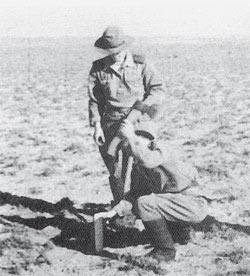
Item management-launch operations and launch the rocket was in an underground bunker at a distance of 200 meters from the start and at a depth of about 8 meters. The largest of the five rooms, equipped with two sea periscopes, the walls were installed remote telemetry. The second large room intended for members of the State Commission for Testing F-7, the guests of honor and the main designers, it also had two periscope. In other areas of the hopper placed monitoring equipment telemetry, control dressing, starting machinery, auxiliary rooms for signalmen and protection.
Next to the training ground growing city. May 5, 1955 was laid the first building. At different times, this city was called differently: Dawn of the village, the village Leninsky, Leninsk. Today we know it under the name Baikonur. According to the original project of the city pledged five thousand permanent staff. The designers made a mistake, not knowing that very soon the number of its inhabitants in the order of casework.
May 15, 1957 held the first test launch of R-7. The rocket left the launch normally. Controlled flight lasted until the 98th of a second, and then it started to fall apart and fell, flying 300 km. The investigation revealed that the immediate cause of the accident was the in-flight fire in the block D.
The next launch held in two months. In flight, the rocket began to rotate about the longitudinal axis, and 33 seconds of "package" has collapsed. Blocks fell around 7 km from the start, and exploded.
Only August 21, 1957 held a successful launch of R-7. Overcoming the distance 6300 km, the weight mock warhead hit targets on the Kamchatka Kura test site.
The construction of the test site and the first rockets were carried out under the strictest secrecy. Even civilian specialists forbade mention anywhere about the existence of Tyr-Tam. It did not help - the CIA quickly learned about the construction, and 5 and 28 August on the training ground planes flew reconnaissance «U-2." As a result of fly Americans built a model site and considered that one missile, which is under development, can not represent a serious threat. They were wrong: October 4, 1957 from the landfill was launched R-7 to deliver into orbit artificial satellite PS-1 (the simplest satellite). This event shook the world - the Soviet Union suddenly became a leader in space exploration.
Ship
With such a powerful rocket, as the R-7, Soviet designers playfully conquered one priority after another. For the first satellite was followed by a second, with the dog Laika (3 November 1957), and the third, which was a heavy research station (15 May 1958).
Equipping R-7 booster block E, which allows to reach escape velocity, missile troops launched the first artificial planet ("Luna-1" launch 2 January 1959), brought the pennant to the Moon ("Luna 2" launch Sept. 12, 1959) and photographed its reverse side ("Luna-3" launch on Oct. 4, 1959). But the team of Sergei Korolev were waiting for a truly epochal event - launch a man into space.
Scientific research rocket USSR, created on the basis of fighting ballistic missiles (left to right): R-1A (1949); P-1B (1951); R-1E (1954); R-2A (1957); 5A-P (1958); P-5B (1962); P-5B (1964); "Vertical" (1970). Figure Alexander Shlyadinskogo.

The development of manned spacecraft began May 22, 1959, after the adoption of the Resolution of the Central Committee of the CPSU and the USSR Council of Ministers "On creation of the objects" Vostok "for human space flight and other purposes" for № 569-264. It is noteworthy that, according to this decree, the Bureau of Korolev was to design not only the manned spacecraft, but unified with it an automatic satellite reconnaissance "Zenith" - because of the "East" was for many years kept secret, data on its form and layout in the press have not been published.
Designing the "East" was engaged in a group led by engineer and future cosmonaut Konstantin Petrovich Feoktistov. No one in the late 1950s did not know how to look manned spacecraft. It was known only that the greatest threat to the life of the pilot will be returning to Earth. Fast braking in the dense layers of the atmosphere could cause a tenfold overload. Therefore, designers originally designed as a cone device - he may plan and thereby reduce congestion twice. However, tests on volunteers showed that the trained people well able to withstand ten times overload, so Feoktistov offered an unusual solution - to make a spherical ship, like the first satellite. This form was well known to specialists in aerodynamics, and therefore did not require additional studies. But to make the whole ship in the form of a ball is not allowed dimensions rocket, so it is divided into two parts: a spherical lander, which was a pilot and instrument compartment that remained after the separation in space.
"East" could not change the orbit, the launch of its parameters were set, so the control was reduced to only one maneuver - inhibition in space and decrease the atmosphere. To accomplish this maneuver in the instrument compartment placed retropropulsion SFT-1 design Alexei Mikhailovich Isayev. Installing worked hypergolic fuel and without duplication was to ensure the smooth launch of a vacuum. This complex technical problems brilliantly decided - SFT-1 has never failed. But in the event of failure of the ship's orbit was adjusted so that he could get away with it on their own at the expense of natural braking in the upper atmosphere.
To brake the acceleration is not turned, the ship must be properly oriented in space. For this purpose, "East" implemented two schemes orientation.
Auto orientation run either on command from the Earth, or the on-board software and vremenny`m device or driver. The ship was flying in the direction of the Earth's rotation, from west to east. Accordingly, it is necessary to brake the engine to turn to the sun. Therefore, device-service module deployed solar sensor of three photovoltaic (unit "Griffin"). Managing a set of micro motors fueled by compressed nitrogen system unfolded orientation of the ship so that the solar cells went from a maximum current. The selected direction supported gyroscopes. Before issuing the pulse braking system passed the test if for a minute predetermined orientation is strictly maintained, started working SFT-1. The process of orientation takes a few minutes, but no more than half an hour.
The failure of the orientation of the pilot could switch to manual control. For him, we developed an unusual optical system - the window underneath the feet, embedded tracker "gaze", which includes two ring-mirror reflector, filter and glass mesh. The rays coming from the horizon, fell for the first reflector and then through the glass window were on the second reflector, which directed them through the glass with a grid on the eye astronaut.
all.
Source:
Countdown History of Cosmonautics decided to conduct in May 1903 - that is when an article was published in Kaluga-taught scientist Konstantin Tsiolkovsky "Investigation of outer space rocket appliances." It scientist has shown that flight into space may be implemented using only missiles with engines with liquid fuels. There he led a formula that now bears his name and which linked the speed of the rocket with its mass and with a flow rate of combustion products. Using this formula, you can easily determine which fuel suitable for space rocket, and what - no.
The article went unnoticed, but because later theorists Space - Frenchman Robert Esnault-Pelterie, American Robert Goddard and the German Hermann Oberth - made its own calculations, independently came to the same conclusions.
The first liquid fuel rocket created and launched by Robert Goddard. It happened March 16, 1926 in Obёrne (Massachusetts). A miniature missile «Nell», is used as a combustible fuel, and an oxidizer - liquid oxygen, climbed to an altitude of 12, 5 m. The result is modest, but by that time the name of Goddard was already widely known - about it wrote as a man who almost tomorrow is going to fly to the moon.
Sensational plans for the publication of the American engineer led to increased interest in the missile and space topics in the German republic and Soviet Russia. At the end of 1923 Hermann Oberth published his fundamental work "The rocket into interplanetary space." In addition to her calculations were given sketches of missiles of two types: sub-orbital (for the study of the higher layers of the atmosphere) and space (to fly into orbit and to the Moon). Affected Technical conceived project - nothing like this in Europe are still not there. In Germany, there was a rocket boom, which eventually contributed to the advancement of Wernher von Braun - a talented designer, under whose leadership in the early 1940s were built heavy ballistic missiles A-4, infamous as the V-2.
After the publication of Oberth Konstantin Tsiolkovsky still managed to defend his priority in theoretical astronautics, and in Soviet Russia he found followers.
Konstantin Tsiolkovsky

Engineer Friedrich Zander and aircraft designer Sergei Korolev in Moscow created a study group's Jet Propulsion (GIRD), which developed ballistic missiles and gliders with rocket engines - rocket planes. In Leningrad Gas Dynamics Laboratory (GDL) missile issues involved "dvigatelisty" Valentin Petrovich Glushko. August 17, 1933 GIRD employees launched the first Soviet liquid rocket - GIRD-09.
In October 1933, based on the GIRD and GDL set Jet Research Institute (RNII). It was a purely military organization, and themes fly into space there is not openly discussed. Nevertheless, among the projects and the rocket it was RNII "service engaged not only fighting, but also a live load."
The designs of the Soviet missile before the Second World War could not be realized. Guide RNII came under repression. They were arrested and have been "prison universities" Korolev and Glushko. Of all the many developments in the war RNII only used rocket mortars Truck mounted BM-13 - the famous "Katyusha».
However, experience with ballistic missiles V-2, which the Nazis fired on London forced the Soviet leadership to think, and when the war ended, in defeated Germany military experts went to examine the missiles, to reproduce them in our environment and create a more perfect.
On the basis of the artillery factory № 8, located in Podlipki near Moscow, was organized by the NII-88, and in August 1946, the chief designer of the R-1, exactly reproduces the German V-2, was appointed Sergei Pavlovich Korolev.
To test missiles in the vicinity of the village of Kapustin Yar in the Astrakhan region constructed landfill. The first series of launches carried out in the autumn of 1947. V-2 rocket, assembled by the Soviet and German specialists from captured nodes, showed good results: the maximum flight range was 274 km.
A year later they were replaced at the start of the domestic P-1, but the test turned a succession of disasters - said the backlog of domestic technology. He managed to overcome the year, and the fall of 1949 a new cycle starts has passed without an accident.
P-1 inherited all the flaws of V-2. This single-stage rocket fuel mixture alcohol-oxygen had a relatively small range of flight (300 km) and low load capacity (one ton). Sergei Korolev hatched plans to create a truly cosmic rocket and knew that with the P-1 to implement them is impossible. Therefore, in parallel with its increasing its Bureau undertake the development of the extended R-2 missile with a flight range of 600 km. While working on the latter was feared that the return to the peak of a ballistic trajectory, which was already out of the atmosphere, long missile faults and overload warhead is delivered to the target. Then, the idea to make a detachable head part. The idea tested in the R-1, effectively creating a new modification of the missile - P-1A. The "Annushka" (as it was called missile troops) was the fortune: it became the first national geophysical rockets with lifting height of more than 100 km. The detachable warhead scientists placed the recording equipment, and July 22, 1951 at the height of the space went two living beings - mutts dezik and Gypsies.
Preparing the rocket GIRD-09 to run.

However, neither the P-1 or P-2 was not satisfied with the military and political leadership of the USSR - from the Bureau of Korolev waiting intercontinental missile with a range of 8,000 kilometers, capable of delivering a thermonuclear charge weight of 5, 5 tons to the United States. Calculations show that a single-stage rocket can not provide intercontinental range with such a payload. But the two-stage rocket is technologically complicated. How to ensure its stability in flight? How to start the engine of the second stage after the separation of the first? In the early 1950s, no one could give a confident answer to these questions.
And then matured original idea of a "package". She suggested Mikhail Tikhonravov - Korolev associate of GIRD and designer of the first Soviet rocket GIRD-09. Based on the works of Tsiolkovsky, Tikhonravov showed that the stage can not be connected in series and in parallel - so you can start to provide all levels at the start and achieve the required load capacity.
As a result of further research design was born two-stage rocket R-7 ("Seven") with engines running on kerosene and oxygen. It consisted of a central unit A (second stage), similar to a giant spindle is surrounded by four tapered "marginalia" (the first stage) - blocks B, C, D. July 24, 1954 the preliminary design of the R-7 was completed, and that summer issued technical specifications in related organizations.
Preparation of R-1 at Kapustin Yar.

Spaceport
More before it was completed sketch project, started by the Commission on the choice of locations for the new landfill: Kapustin Yar could no longer provide a test of a new missile. In the end the choice was stopped on Kazakhstan, close to the railway station Tura-Tam.
January 12, 1955 in Tyr-Tame first landed landing military builders. They immediately set to work preparing the way for the arrival of the special train from Kapustin Yar. The construction of the landfill was carried out accelerated pace. Already in June 1955 began to build "object 135" - the first launch complex, later known worldwide as "Gagarin's Start".
In the design of the R-7 considered various options complexes. A key question remained build a rocket on the launch pad. Sergei Korolev, and the chief designer of the ground complex Vladimir Pavlovich Barmin settled on the simplest version: transported and placed on the launch pad all the blocks one by one, and then connect them to the second stage. But such an arrangement, a rocket gets very wide at the base. The chief designer of the control system Z Pilyugin gave a negative opinion - his calculations showed that an increase in the lateral thrust blocks there significant tipping point; when combined with such a moment a gust of wind control system can not ensure the stability of the rocket during launch. Alternatively Pilyugin required to protect P-7 by wind action by a high wall. Barmin bluntly refused to discuss the decision: starting position P-7 and without walls looked bulky. Then there was found an unconventional way - to collect the rocket in assembly and testing facility (MIK), then horizontally to transport it by rail to the launch pad, and there are not placed directly on the support, and hang in the power zone in reclining at her rise farms. Immediately simplify and launch pad and the missile itself has become sleeker and lighter.
During the construction of the complex was not without problems. Just a few days before the start of the space on demand "camoufleur" of the General Staff, was transferred from the platform to the lowland. But after construction began it became clear that the existing data exploration can not be applied to the new position start: instead of sand clay were found, and under them - underground lake. Unexpected obstacles can derail a target date, and therefore the project had to start modifying chat along the way, adapting it to new conditions.
The first peg - the beginning of the construction of the landfill Tyr-Tam (Baikonur Cosmodrome).

Item management-launch operations and launch the rocket was in an underground bunker at a distance of 200 meters from the start and at a depth of about 8 meters. The largest of the five rooms, equipped with two sea periscopes, the walls were installed remote telemetry. The second large room intended for members of the State Commission for Testing F-7, the guests of honor and the main designers, it also had two periscope. In other areas of the hopper placed monitoring equipment telemetry, control dressing, starting machinery, auxiliary rooms for signalmen and protection.
Next to the training ground growing city. May 5, 1955 was laid the first building. At different times, this city was called differently: Dawn of the village, the village Leninsky, Leninsk. Today we know it under the name Baikonur. According to the original project of the city pledged five thousand permanent staff. The designers made a mistake, not knowing that very soon the number of its inhabitants in the order of casework.
May 15, 1957 held the first test launch of R-7. The rocket left the launch normally. Controlled flight lasted until the 98th of a second, and then it started to fall apart and fell, flying 300 km. The investigation revealed that the immediate cause of the accident was the in-flight fire in the block D.
The next launch held in two months. In flight, the rocket began to rotate about the longitudinal axis, and 33 seconds of "package" has collapsed. Blocks fell around 7 km from the start, and exploded.
Only August 21, 1957 held a successful launch of R-7. Overcoming the distance 6300 km, the weight mock warhead hit targets on the Kamchatka Kura test site.
The construction of the test site and the first rockets were carried out under the strictest secrecy. Even civilian specialists forbade mention anywhere about the existence of Tyr-Tam. It did not help - the CIA quickly learned about the construction, and 5 and 28 August on the training ground planes flew reconnaissance «U-2." As a result of fly Americans built a model site and considered that one missile, which is under development, can not represent a serious threat. They were wrong: October 4, 1957 from the landfill was launched R-7 to deliver into orbit artificial satellite PS-1 (the simplest satellite). This event shook the world - the Soviet Union suddenly became a leader in space exploration.
Ship
With such a powerful rocket, as the R-7, Soviet designers playfully conquered one priority after another. For the first satellite was followed by a second, with the dog Laika (3 November 1957), and the third, which was a heavy research station (15 May 1958).
Equipping R-7 booster block E, which allows to reach escape velocity, missile troops launched the first artificial planet ("Luna-1" launch 2 January 1959), brought the pennant to the Moon ("Luna 2" launch Sept. 12, 1959) and photographed its reverse side ("Luna-3" launch on Oct. 4, 1959). But the team of Sergei Korolev were waiting for a truly epochal event - launch a man into space.
Scientific research rocket USSR, created on the basis of fighting ballistic missiles (left to right): R-1A (1949); P-1B (1951); R-1E (1954); R-2A (1957); 5A-P (1958); P-5B (1962); P-5B (1964); "Vertical" (1970). Figure Alexander Shlyadinskogo.

The development of manned spacecraft began May 22, 1959, after the adoption of the Resolution of the Central Committee of the CPSU and the USSR Council of Ministers "On creation of the objects" Vostok "for human space flight and other purposes" for № 569-264. It is noteworthy that, according to this decree, the Bureau of Korolev was to design not only the manned spacecraft, but unified with it an automatic satellite reconnaissance "Zenith" - because of the "East" was for many years kept secret, data on its form and layout in the press have not been published.
Designing the "East" was engaged in a group led by engineer and future cosmonaut Konstantin Petrovich Feoktistov. No one in the late 1950s did not know how to look manned spacecraft. It was known only that the greatest threat to the life of the pilot will be returning to Earth. Fast braking in the dense layers of the atmosphere could cause a tenfold overload. Therefore, designers originally designed as a cone device - he may plan and thereby reduce congestion twice. However, tests on volunteers showed that the trained people well able to withstand ten times overload, so Feoktistov offered an unusual solution - to make a spherical ship, like the first satellite. This form was well known to specialists in aerodynamics, and therefore did not require additional studies. But to make the whole ship in the form of a ball is not allowed dimensions rocket, so it is divided into two parts: a spherical lander, which was a pilot and instrument compartment that remained after the separation in space.
"East" could not change the orbit, the launch of its parameters were set, so the control was reduced to only one maneuver - inhibition in space and decrease the atmosphere. To accomplish this maneuver in the instrument compartment placed retropropulsion SFT-1 design Alexei Mikhailovich Isayev. Installing worked hypergolic fuel and without duplication was to ensure the smooth launch of a vacuum. This complex technical problems brilliantly decided - SFT-1 has never failed. But in the event of failure of the ship's orbit was adjusted so that he could get away with it on their own at the expense of natural braking in the upper atmosphere.
To brake the acceleration is not turned, the ship must be properly oriented in space. For this purpose, "East" implemented two schemes orientation.
Auto orientation run either on command from the Earth, or the on-board software and vremenny`m device or driver. The ship was flying in the direction of the Earth's rotation, from west to east. Accordingly, it is necessary to brake the engine to turn to the sun. Therefore, device-service module deployed solar sensor of three photovoltaic (unit "Griffin"). Managing a set of micro motors fueled by compressed nitrogen system unfolded orientation of the ship so that the solar cells went from a maximum current. The selected direction supported gyroscopes. Before issuing the pulse braking system passed the test if for a minute predetermined orientation is strictly maintained, started working SFT-1. The process of orientation takes a few minutes, but no more than half an hour.
The failure of the orientation of the pilot could switch to manual control. For him, we developed an unusual optical system - the window underneath the feet, embedded tracker "gaze", which includes two ring-mirror reflector, filter and glass mesh. The rays coming from the horizon, fell for the first reflector and then through the glass window were on the second reflector, which directed them through the glass with a grid on the eye astronaut.
all.
Source:

